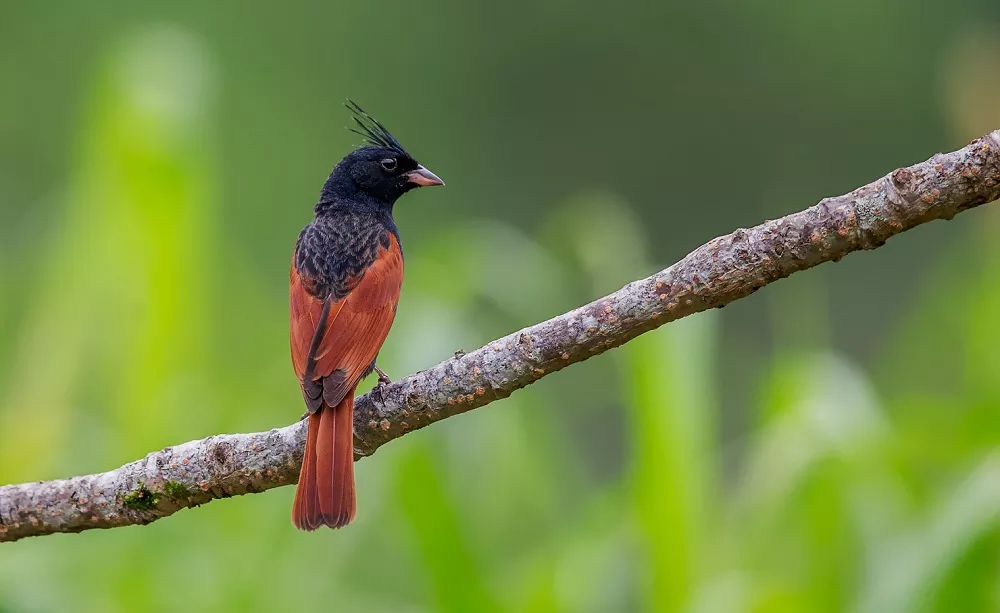The Crested Bunting (Emberiza lathami) stands out as an intriguing avian species that captivates birdwatchers and ornithologists alike. This small passerine bird, known for its distinctive crested head, is found in various regions across the globe. In this article, we delve into the intriguing world of the Crested Bunting, exploring its physical attributes, habitat, behavior, and conservation status.
Physical Characteristics of the Crested Bunting
The Crested Bunting is easily recognizable due to its prominent crested head, which distinguishes it from other bunting species. This crest, composed of elongated feathers, adds an element of elegance to its appearance. Typically, the male Crested Bunting showcases more vibrant plumage, with hues of orange, black, and white, while the female tends to have a more subdued coloration, blending well with its surroundings. This dimorphism serves various purposes, including mate attraction and camouflage.
Habitat and Distribution
Crested Buntings are primarily found in East Asia, particularly in China, Japan, and Korea. They inhabit a variety of habitats, including open woodlands, grasslands, shrublands, and agricultural areas. These birds prefer areas with dense vegetation and tall grasses, providing them with ample cover for nesting and foraging. During the breeding season, they are known to migrate to higher altitudes, where they build their nests in shrubs or low trees.
Migratory Behavior
One of the most fascinating aspects of the Crested Bunting is its migratory behavior. In certain parts of its range, the species exhibits migratory tendencies, undertaking long journeys between breeding and wintering grounds. These migrations are often prompted by seasonal changes, resource availability, and the search for suitable nesting sites. Studying the patterns of Crested Bunting migration has been crucial in understanding the factors influencing their population dynamics.
Behavior and Diet
Crested Buntings are generally solitary birds, although they may form small flocks during migration or winter months. Males are highly territorial and defend their nesting territories vigorously. Their courtship displays involve singing from an exposed perch while raising and lowering their crest feathers. The melodious song of the Crested Bunting is a delightful combination of trills, whistles, and warbles.
In terms of diet, Crested Buntings are primarily granivorous, feeding on a variety of seeds, grains, and grasses. They also consume small insects and invertebrates during the breeding season to supplement their diet and provide essential nutrients for their young.
Breeding and Nesting
During the breeding season, the Crested Bunting engages in elaborate courtship displays to attract potential mates. These displays often involve intricate songs and aerial acrobatics to demonstrate their vitality and fitness. Once a pair forms a bond, they work together to construct a well-hidden nest on the ground, concealed amidst vegetation. The female lays a clutch of eggs, which she incubates while the male assists by providing food. Observing their nesting behavior has been a challenging yet rewarding endeavor for researchers.
Conservation Status and Threats
The Crested Bunting faces several threats that have led to a decline in its population. Habitat loss due to urbanization, agricultural expansion, and deforestation is one of the primary concerns. Additionally, illegal trapping for the cage bird trade has had a significant impact on their numbers. Climate change and changes in land use patterns further exacerbate these threats.
As a result of these factors, the Crested Bunting is listed as a species of conservation concern. Efforts are underway to protect its habitat, raise awareness about its conservation needs, and enforce regulations against illegal trapping and trade. International collaborations and research initiatives are crucial in understanding the species’ ecology and implementing effective conservation strategies.
Conclusion
The Crested Bunting continues to enthrall bird enthusiasts with its unique appearance, behavior, and adaptability. As researchers delve further into the intricacies of its life history, migratory patterns, and breeding habits, we gain valuable insights into the ecological dynamics of this fascinating species. By recognizing and addressing the challenges it faces, we can ensure the long-term survival of the Crested Bunting and preserve its beauty for generations to come. Let us continue to marvel at the wonders of nature and strive to protect the rich diversity of avian life that graces our planet.


 Facebook
Facebook  Instagram
Instagram  Youtube
Youtube 